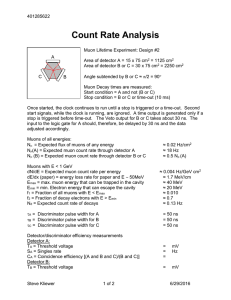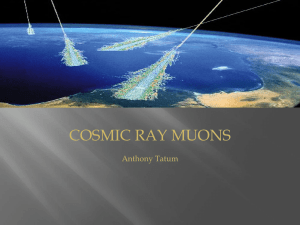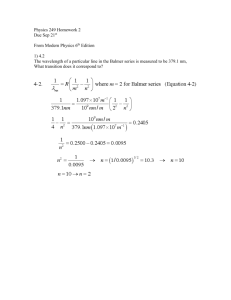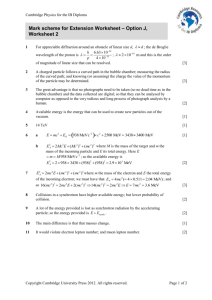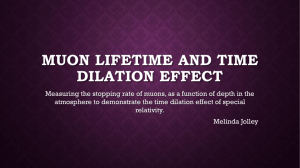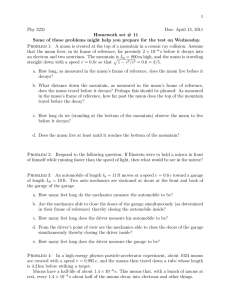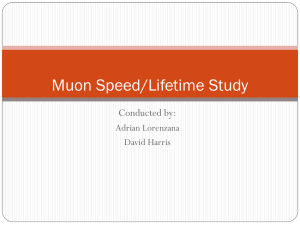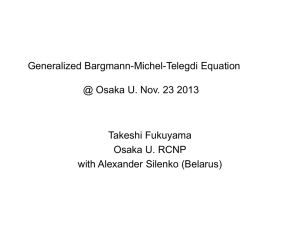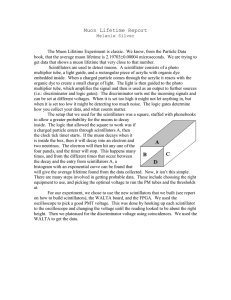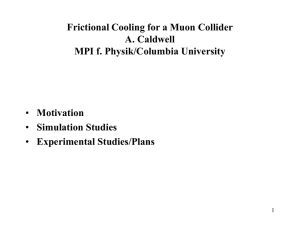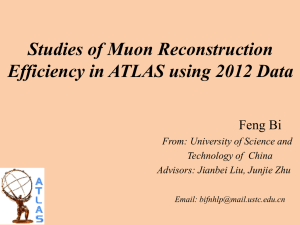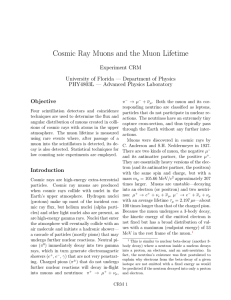Energy Distribution of Cosmic Ray Muons
advertisement
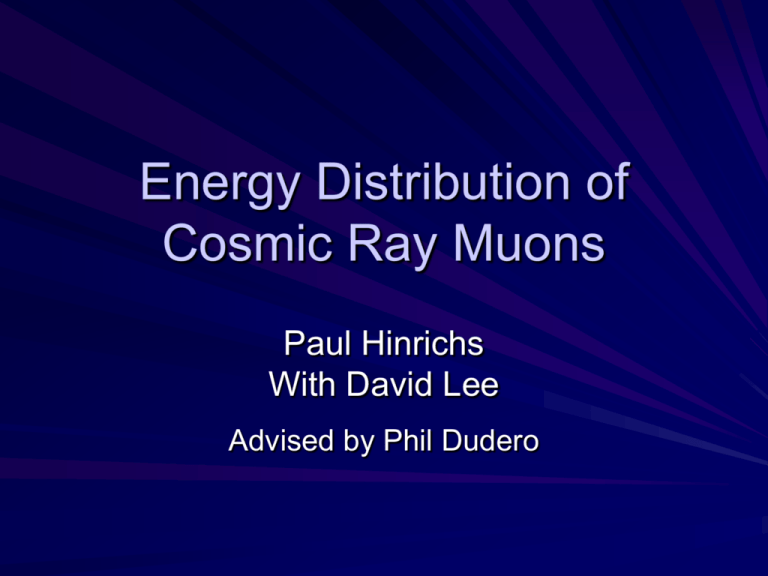
Energy Distribution of Cosmic Ray Muons Paul Hinrichs With David Lee Advised by Phil Dudero The Experiment Cosmic rays are particles impingent on Earth from outer space – Appear at Earth’s surface mainly as muons Goal of the experiment: measure the energy distribution of cosmic ray muons at Earth’s surface References describe the muon energy spectrum as “almost flat below 1 GeV” The Experiment Discriminator Counters (6) Three scintillation detectors: photomultiplier tube with plastic paddle Absorber material slows or stops incoming muons; here, lead (r=11.4 g/cm³) Electronics to process and read out PMT signal Measure energy by varying the absorber thickness and examining the ratio of count rates PMT A Coincidence Logic Unit PMT B NIM-TTL Adapter PCI Timer/Counter Computer PMT C The Apparatus The Apparatus The Discriminator PMT outputs a raw negative pulse, about 100mV high and lasting about 10ns Discriminator cleans this raw signal up: whenever the PMT output goes below a threshold voltage, the discriminator outputs a NIM logic pulse of fixed length Set threshold voltage to change sensitivity The Discriminator Coincidence Unit Four-way coincidence unit: 4 selectable input channels Buttons on the front allow independent selection of each channel The coincidence unit pulses if all selected channels pulse simultaneously Other Logic Counters display number of counts since they were last reset NIM-TTL adapter converts NIM pulses (negative true, about -1V) to standard TTL logic (positive true, +5V) Adapter is needed to interface with computer, which only accepts TTL signals Computer Data Collection The computer collects data with a NI 6602 PCI counter and timer card – 3 input channels The counting program, written by Kurt Wick and modified by us, counts for N periods of length T Allows us to record and later analyze data over time: we have counts for each minute of data collection, not just totals Calibration PMTs first require calibration More than one variable: – PMT drive voltage determines sensitivity, pulse height, noise – Discriminator threshold can cut out some noise, though not all Usually, discriminator threshold is set low, and the coincidence unit discards uninteresting events Calibration Procedure Align all three paddles directly on top of each other Set the coincidence unit to output coincidences on: – AC, the top and bottom panels – ABC, all three panels Adjust the supply voltage and threshold voltage for B until the ratio ABC:AC is ~1 Permute A, B, C and repeat for A and C Muon Absorption Need to know what particle energies are stopped by a given amount of lead In this energy range, almost all energy loss is due to ionization Use the Bethe-Bloch equation to predict energy loss of incoming muons, as a function of their current energy: 2 Qmax dE Z 1 1 2me c 2 2 2Qmax (E) C(E) 2 K ln 2 2 4 2 2 2 dx A I 2 M c Z Muon Absorption Use MATLAB to evaluate and plot –dE/dx: Muon Energy Loss in Lead 50 45 40 -dE/dx (x in cm) 35 30 25 20 15 10 5 0 0 200 400 600 800 1000 E (MeV) 1200 1400 1600 1800 2000 Muon Absorption Knowing –dE/dx, we can calculate the range R of a muon with energy E’: E dx R R( Ecut ) dE Ecut dE Choosing Ecut sufficiently small (0.15 MeV here) means we can neglect it, and consider only the integral contribution Integrate numerically with MATLAB to find the range of a muon with given energy Can also solve numerically for Emin given Rmax Muon Absorption Muon Range in Lead 180 160 Maximum Range (cm) 140 120 100 80 60 40 20 0 0 200 400 600 800 1000 E (MeV) 1200 1400 1600 1800 2000 Experimental Errors Error in numerical computations is negligible Bethe-Bloch equation, using the continuous stopping approximation, is only about 1–2% accurate in predicting muon range Path length differences are only 0.1–0.2%, given the dimensions of our apparatus Statistical error, proportional to N Practical Considerations Maximum range: – About 130 cm available for lead – Theoretical maximum absorption ~1.7 GeV Point Granularity – Each lead brick is 5 cm thick Statistics – Low count rate: about 300 triple coincidences in 24 hours with no bricks Preliminary Results Data from a typical run: Totals: Counts over 24 hours, 24 Layers of Bricks (120 cm Pb) 9 Channel Counts AB AC ABC A – 1275 8 B – 232 7 C – 110 6 5 Per Minute: 4 A – 0.885 3 B – 0.161 2 C – 0.076 1 0 0 120 240 360 480 600 720 840 960 1080 Minute, from 11:50AM, April 12 to 11:50AM, April 13 1200 1320 1440 Preliminary Results Detector geometry means total flux through ABC, assuming no absorption, has the form FABC, Expected = K FAB Use data collected with no absorber to determine K experimentally We can then examine the ratio FABC, Measured / FABC, Expected to determine how much flux is being stopped Preliminary Results Muon Flux vs Maximum Energy Attenuated 1.2 1 Muon Flux Ratio 0.8 0.6 0.4 0.2 0 0 200 400 600 800 1000 Maxim um Energy Attenuated (MeV) 1200 1400 1600 1800 Preliminary Results Observed Particle Energy Distribution 0.8 PDF CDF 0.7 Probability of Observation 0.6 0.5 0.4 0.3 0.2 0.1 0 0 200 400 600 800 1000 Particle Energy, MeV 1200 1400 1600 1800 Future Work Take more data Try to calculate K analytically and compare with the measured value – Difference between expected and observed values give the efficiency of the detector Refine computation of distribution function References Particle Data Group, Review of Particle Physics (2006). Leo, William R., Techniques for Nuclear and Particle Physics Experiments, Springer-Verlag, Berlin, 1994. Groom, D.E., Striganov, N.V., and Mokhov, S.I.; Muon Stopping Power and Range Tables 10 MeV–100 TeV, Atomic Data and Nuclear Data Tables 78, 183–356 (2001). Questions? Acknowledgements: – Phil, for general advice – Kurt Wick, for helping us set up the apparatus – Professor Michael DuVernois, for providing supplemental equipment, along with expertise – Michael Hamman and Timothy Weaver, who worked on this project during MXP last year – Peter Karn and Dave Kearsley, for general help and emotional support
